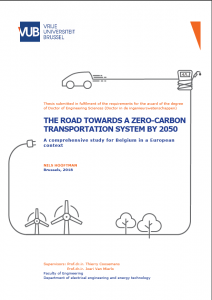
Human activity is putting a tremendous strain on the environment. Not only are we spending our carbon budget too rapidly to keep the global temperature increase below 2 degrees Celsius, butwe are also poisoning the air we breathe in urban regions, as roads clog with combustion-based vehicles. Thus, air pollution causes several hundreds of thousands of European citizens to die prematurely every year. As both the European population, its mobility, and its material needs are forecast to increase significantly by 2050, the cry for measures to counter business-as-usual is growing louder. In this dissertation, we focus on the impact passenger cars have on society and on the environment.
Since the overall efficiency of conventional petrol and diesel engines is reaching the boundaries of its potential, the electrification of powertrains has become inevitable. The pace at which this process has been taking place over the last decade, however, indicates the reluctance of the European automotive industry to let go of thermal power sources. Meanwhile, fully electric vehicles (EV) are ready to take over, although it feels like they are systematically being held back by the very industry that manufactures them. Despite all this, the presented manuscript proves that EVs are key to improve local emissions when considering both regulated and unregulated pollutants, as well as upstream emissions within the national borders. EVs are roughly six times less harmful to human health than recent diesel cars, while being half as harmful as a recent petrol car. Considering an extensive review of the passenger car sector in the EU and the regulations it is subjectedto, this situation is not expected to change significantly in the coming decade unless an ambitious, successive Euro emission standard is issued. We draw this conclusion despite the implementation of real-world driving emission testing, as narrow boundary conditions for testing cover only part of the engine’s operating range. For EVs, limits to sustainability are linkedto the battery size, both due to current practices in the mining sector as to increasing non-exhaust emissions of particulate matter. Also, the larger the battery becomes, the more pronounced the impact of the feedstock for electricity production gets. If we fast-forward to 2050, a nearly-decarbonised society should have taken form, as stipulated in the Paris Agreement. By backcasting the 2050 targets for greenhouse gas emissions by the transport sector to date, a tremendous task arises ahead. Given the relatively easier option of decarbonising passenger cars rather than heavy-duty transport or aviation, we discuss six pathways – or scenarios – towards the Paris Agreement’s objective. To keep the 2050 targets within reach, the three most ambitious scenarios require substantial shifts from near-total internal combustion engine (ICE) dominance today, to somewhere between 86% and 94% in 2020, relative to over 99% anno 2018. By 2035 the latest, conventional car sales should be phased-out. Postponing drastic action results in even more radical measures further down the line.
We conclude with a status check for the market uptake of zero-emission vehicles (ZEV). Despite outlier markets like China and Norway, European ZEV sales remain dramatically low, representing about 0,77% of the 2018 sales to date. Analysis of incentives and consumer markets shows that people need to be educated on the benefits of ZEVs, as they tend to be systematically biased and prefer to hold on to the status quo. Also,pointof sales subsidies areappreciated more than post-purchase reimbursements, while a feebate system guarantees that the subsidy framework is self-sustaining. The task for governments is to proclaim a long-term vision for ZEVs in transport, in order for both consumers and the industry to know what the future will look like and by when milestones must be reached. In the meantime, the industry should stop withholding EV models to create a perception that the technology is not ready.
